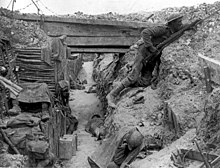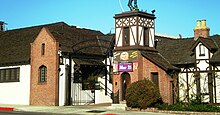Rifle over
| Movie | |
|---|---|
| German title | Rifle over |
| Original title | Shoulder arms |
| Country of production | United States |
| original language | English |
| Publishing year | 1918 |
| length | 45 minutes |
| Rod | |
| Director | Charles Chaplin |
| script | Charles Chaplin |
| production | Charles Chaplin |
| music | Charles Chaplin |
| camera | Roland Totheroh |
| cut | Charles Chaplin |
| occupation | |
| |
Gun Over is a 1918 American comedy film directed by Charles Chaplin .
action
Charlie becomes a recruit in the US Army during World War I and is sent to a training camp. The first difficult exercise for him is marching in lockstep, where his typical Chaplin walk gives him the first difficulties with the training sergeant. The sergeant requires him to straighten his feet, not outward. This makes marching difficult for Charlie. Overtired, he falls into his tent and falls asleep.
Charlie comes to the front in France . Equipped with the rifle, a mousetrap and a kitchen grater . He hangs the grater on the wall in the shelter and rubs his itchy back with vermin. He has to keep watch in the trenches . The onset of rain not only bothered him when he was on duty, but also after the changing of the guard in the shelter, which gradually fills with water. However, the soldiers are now so indifferent that even this can no longer hold them back from sleep. Charlie uses a funnel to breathe while sleeping.
An attack is ordered. The soldiers prepare for the attack in the trenches. For Charlie, however, the day doesn't seem to hold good omen. His identification tag has the number 13. When he tries to encourage himself and hits his chest, his hand mirror breaks in his breast pocket. But Charlie returns from the attack as a hero and has captured 13 German soldiers. When his supervisor asks him how he managed to do this, he claims he surrounded her.
Charlie is given the task of spying on the enemy. Disguised as a tree, he goes into the no man's land between the fronts. German soldiers run into him with an American prisoner. You are resting and want to make a fire. A German soldier is looking for firewood and Charlie discovers the tree. Little by little, Charlie kills the soldiers with blows of his branches and frees the American comrade.
In a bombed-out house, Charlie discovers a French girl who is threatened by German soldiers. He frees the girl. The emperor appears with Hindenburg on the scene. He visits the front. Charlie disguises himself as a German officer and can thus free his American comrade again and kidnap the emperor. He drives back across the lines in the Emperor's car to the American front and is celebrated as the hero who ended the war. Finally, Charlie wakes up from his dream in his tent in the training camp.
background
In March 1918, the shooting of the film with the title A Dog's Life ended - in this country: A dog's life . Immediately after graduation, the filmmaker went on a tour of the United States with Douglas Fairbanks and Mary Pickford to promote the purchase of war bonds . Chaplin's next film should then also have the First World War on the topic: The Bond ( Bond ). After some effort to find a suitable storyline (he was still working without a script), Gewehr also emerged , which became one of the greatest financial successes of his career.
Chaplin began producing the film in May 1918. Most of the filming took place in the summer. The very realistic looking trenches and shelters were built on the site of Chaplin's studio in Hollywood . The scenes in the barren no man's land were shot in the rural part of Hollywood behind Beverly Hills . When the film was finished in September, he had doubts as to whether a comedy film was the right way to deal with the horrors of war. He wanted to destroy it at first, but the reactions of his friend Douglas Fairbanks after a private screening of the film convinced him to bring the film out. The premiere finally took place on October 20, three weeks before the end of the war. The strip was very successful and was particularly well received by the former soldiers at the front.
When Chaplin republished his work almost half a century later in the compilation film The Chaplin Revue (1959), he preceded the film with documentary scenes from the First World War, which show how realistically the trenches were built. The film also received music that he composed himself.
The film was only released in German cinemas after the Second World War . It was the only long film by Chaplin that the Germans didn't get to see at the time.
Reviews
“No one else should have dared to ridicule the terrible as his genius did - this mockery of militarism, this bizarre comedy of movements, this lightning-fast alternation between sentimentality, genuine feeling, gossip and caricature, that is something completely Unique. "
“A legendary satire on the military in general and the German Kaiser in particular. It combines wonderful scenes with some formal weaknesses that result from the fact that, despite the exaggeration into the grotesque, the concentrated naturalism of the beginning and thus Chaplin's vehement accusation against the war is increasingly weakened. "
Web links
- Gun over the Internet Movie Database (English)
swell
- ↑ David Robinson: Chaplin. His life, his art . Diogenes, Zurich 1993, ISBN 3-257-22571-7 . Pp. 290-292
- ↑ Time assembly. Charlie Chaplin, Berlin 1989, p. 112f
- ↑ rifle over. In: Lexicon of International Films . Film service , accessed April 8, 2017 .

